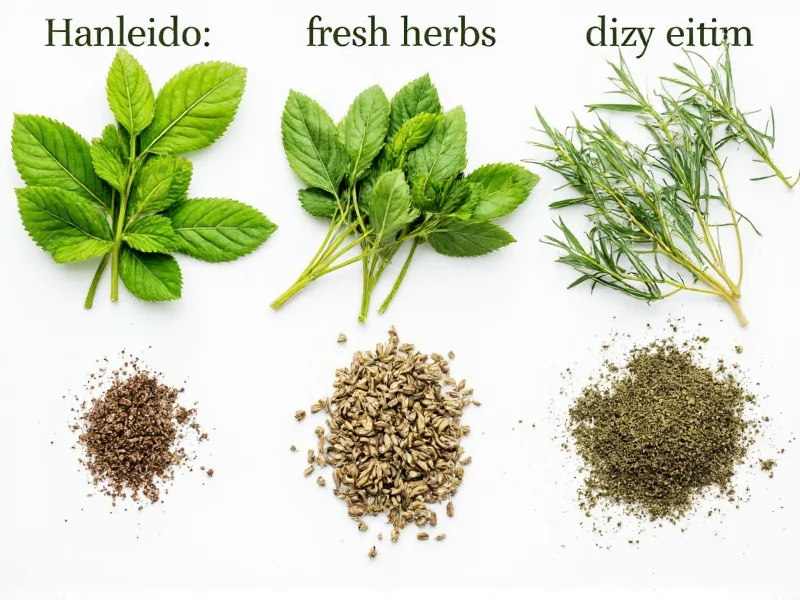Understanding proper herb conversion is essential for achieving balanced flavors in your cooking. Many home chefs struggle with substituting dried herbs for fresh ingredients, often resulting in dishes that are either bland or overpowering. The difference in potency between fresh and dried herbs stems from the water content removal during the drying process, which concentrates the essential oils and flavors.
The Science Behind Herb Conversion Ratios
When herbs are dried, they lose approximately 80-90% of their water content. This concentration effect means dried herbs deliver more intense flavor in smaller quantities. The general 3:1 ratio (three parts fresh to one part dried) serves as a reliable starting point, but understanding the nuances can elevate your culinary results significantly.
Factors Affecting Fresh to Dried Herb Conversion
Several elements influence the precise conversion ratio needed for optimal flavor:
- Herb type - Delicate herbs like cilantro and basil behave differently than woody herbs like rosemary and thyme
- Drying method - Oven-dried, air-dried, and commercially dried herbs have varying potency levels
- Storage duration - Dried herbs lose potency over time, affecting required quantities
- Cooking technique - Long-simmered dishes versus quick-cooking recipes require different approaches
Comprehensive Fresh to Dried Herb Conversion Chart
| Herb Type | 1 Tbsp Fresh = | 1 tsp Dried = | Special Notes |
|---|---|---|---|
| Basil | 1 tsp dried | 1 Tbsp fresh | Use 25% less for long-cooking dishes |
| Parsley | ¾ tsp dried | 1¼ Tbsp fresh | Fragile flavor; add dried early in cooking |
| Rosemary | ½ tsp dried | 1½ Tbsp fresh | Strong flavor; crush dried before using |
| Thyme | ¾ tsp dried | 1¼ Tbsp fresh | Woody stems affect measurement accuracy |
| Oregano | ½ tsp dried | 1½ Tbsp fresh | Dried has stronger flavor profile |
| Cilantro | 1 tsp dried | 1 Tbsp fresh | Dried lacks fresh brightness; use sparingly |
| Dill | 1 tsp dried | 1 Tbsp fresh | Fragile; loses flavor quickly when dried |
| Mint | ¾ tsp dried | 1¼ Tbsp fresh | Stronger when dried; adjust to taste |
When to Adjust Standard Conversion Ratios
While the 3:1 fresh to dried herbs conversion serves as a reliable guideline, certain cooking scenarios require adjustments. For dishes with extended cooking times (like stews or braises), reduce dried herb quantities by 25% since prolonged heat exposure intensifies their flavor. Conversely, for quick-cooking dishes like sautés or finishing touches, you might need to increase dried herb amounts slightly as they have less time to release their oils.
Understanding how to substitute dried herbs for fresh properly prevents common culinary mistakes. Many home cooks make the error of using equal measurements, resulting in overpowering flavors that dominate the dish. The key is recognizing that dried herbs aren't simply dehydrated versions of fresh—they're concentrated flavor agents requiring careful measurement.
Practical Tips for Using Dried Herbs Effectively
Maximize the flavor potential of dried herbs with these professional techniques:
- Toast before use - Briefly heating dried herbs in a dry pan releases more essential oils
- Add early for robust dishes - Incorporate dried herbs at the beginning of long-cooking recipes
- Add late for delicate dishes - Stir in toward the end for quick-cooking preparations
- Crush between fingers - Releases more flavor compounds before adding to dishes
- Store properly - Keep in airtight containers away from light and heat to maintain potency
Common Herb Conversion Mistakes to Avoid
Even experienced cooks sometimes misjudge herb conversions. The most frequent error is treating all herbs as having identical conversion ratios. Delicate herbs like tarragon and dill lose more flavor during drying than robust herbs like oregano and thyme. Another common mistake is not accounting for the age of dried herbs—those stored longer than six months have significantly reduced potency, requiring slightly larger quantities.
When converting fresh to dried herbs for baking applications, particularly in breads and savory pastries, use 20% less than standard ratios since the concentrated flavors can become overwhelming in delicate doughs. For salad dressings and cold applications, consider using fresh herbs whenever possible, as dried herbs don't properly hydrate in cold preparations.
Frequently Asked Questions
Can I always use the 3:1 ratio for fresh to dried herb conversion?
While the 3:1 ratio (3 parts fresh to 1 part dried) serves as a good starting point, it's not universal for all herbs. Delicate herbs like cilantro and dill often require slightly different ratios than robust herbs like rosemary and thyme. The chart provided shows specific conversions for each herb type for optimal results.
Why do dried herbs require less quantity than fresh herbs?
Dried herbs require less quantity because the drying process removes 80-90% of the water content, concentrating the essential oils and flavor compounds. This concentration means a smaller amount of dried herb delivers equivalent flavor to a larger quantity of fresh herb.
How should I adjust dried herb measurements for long-cooking dishes?
For long-cooking dishes like stews or braises, reduce dried herb quantities by approximately 25% from standard conversion ratios. The extended cooking time allows more flavor extraction from dried herbs, which can become overpowering if standard measurements are used.
Do dried herbs lose potency over time?
Yes, dried herbs gradually lose potency over time. Properly stored in airtight containers away from light and heat, they maintain good flavor for 6-12 months. After this period, you may need to increase quantities slightly to achieve the same flavor intensity, though extremely old herbs are best replaced entirely.
Can I substitute dried herbs for fresh in all recipes?
While you can substitute dried herbs for fresh in most cooked dishes, they're not ideal for all applications. Dried herbs don't properly hydrate in cold preparations like salad dressings or fresh salsas, where fresh herbs provide better texture and brighter flavor. For finishing touches on dishes, fresh herbs generally deliver superior results.











 浙公网安备
33010002000092号
浙公网安备
33010002000092号 浙B2-20120091-4
浙B2-20120091-4